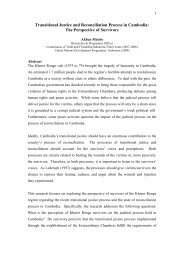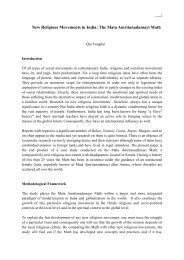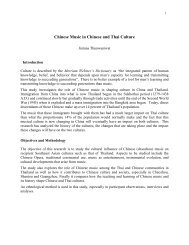Private Sector Participation in Affirmative Action in Malaysia: - Asian ...
Private Sector Participation in Affirmative Action in Malaysia: - Asian ...
Private Sector Participation in Affirmative Action in Malaysia: - Asian ...
You also want an ePaper? Increase the reach of your titles
YUMPU automatically turns print PDFs into web optimized ePapers that Google loves.
clipp<strong>in</strong>gs, political parties manifesto, parliamentary debates and similar literature.<br />
However, to complement and validate the secondary literature, the study has undertaken<br />
fair amount of fieldworks ma<strong>in</strong>ly through personal <strong>in</strong>terviews with key officials, people’s<br />
representatives, representatives of private sector and other stakeholders related to<br />
affirmative programmes largely to supplement the <strong>in</strong>adequacy <strong>in</strong> exist<strong>in</strong>g empirical data.<br />
There were <strong>in</strong>terviews with lead<strong>in</strong>g entrepreneurs (foreign owned, Bumiputera owned,<br />
Ch<strong>in</strong>ese, Indian), politicians, top civil servants, academics, civil society leaders, media<br />
representatives and key policy makers.<br />
Scope of the Project<br />
The research project will seek to explore various facets of <strong>Malaysia</strong>’s tryst with private<br />
sectors, context, processes and dynamics of seek<strong>in</strong>g private sector participation, nature of<br />
tradeoffs between the government and the private sector players and the outcome of the<br />
participation. The key focus is on the aspects of corporate equity, employment quota and<br />
creation of tra<strong>in</strong><strong>in</strong>g opportunity by private sector for Bumiputera. Further, the study will<br />
go <strong>in</strong>to the details of political dynamics of rul<strong>in</strong>g parties, leadership role and other state<br />
apparatus <strong>in</strong> shap<strong>in</strong>g such controversial policies, <strong>in</strong>dustries responses, and evolution of<br />
broad framework of negotiation among different groups/players, outcome and current<br />
status of affirmative polices <strong>in</strong> private sector. In the end, there is an attempt to<br />
contextualize <strong>Malaysia</strong>n experience <strong>in</strong> India’s current preoccupation to have some sort of<br />
affirmative action <strong>in</strong> private sector. Major limitation of the current study is author’s<br />
command over Bahasa Malaya. Given the majority of Malays speak Bahasa Melayu,<br />
<strong>in</strong>terviews and personal <strong>in</strong>teractions will face some challenges although <strong>in</strong> select and<br />
important cases, attempts have been made to overcome this limitations through a local<br />
translator.<br />
Race, Inequality and <strong>Private</strong> <strong>Sector</strong> <strong>in</strong> <strong>Malaysia</strong><br />
<strong>Malaysia</strong> is a multi-racial country comprised of three major ethnic groups the Malays and<br />
other <strong>in</strong>digenous groups together called Bumiputera (Bumiputera and Malay are used<br />
<strong>in</strong>terchangeably <strong>in</strong> this paper) account<strong>in</strong>g for 67 per cent of total population, the Ch<strong>in</strong>ese<br />
who make up about 25 per cent and the Indians 8 per cent of the total population. A<br />
4







